International

World Growth Forums Magazine June 2023
Keynote Speech by Dr Alfredo Sfeir-Younis _ WGF-GBIF Thailand 2024
What Is a Ceasefire Agreement?
In the midst of ongoing conflicts and humanitarian crises, ceasefire agreements serve as pivotal moments of hope and relief. The recent ceasefire of January 18, 2025 between Israel and Hamas, coupled with the release of hostages, provides an opportunity to understand what a ceasefire agreement entails and its significance in global diplomacy.
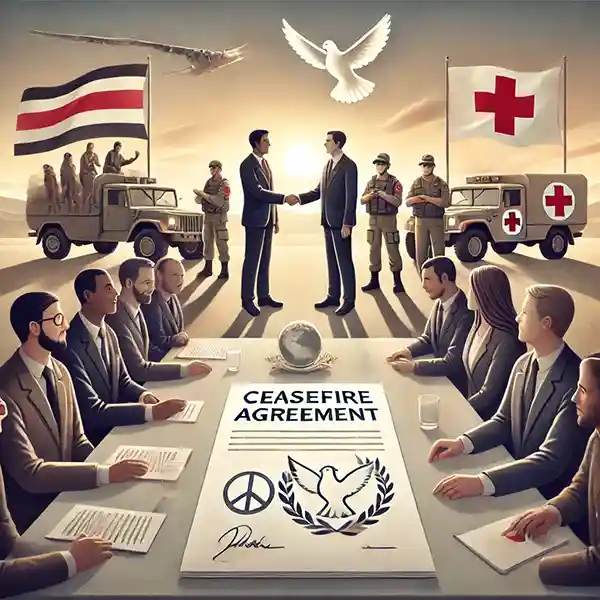
Image 1: An illustrative image explaining the concept of a ceasefire agreement in the context of global diplomacy. The scene includes two groups of people representing conflicting parties (symbolic rather than specific nationalities) shaking hands across a negotiation table. On the table lies a document labeled ‘Ceasefire Agreement,’ with peace symbols (dove, olive branch) subtly integrated into the background. In the distance, humanitarian aid trucks and Red Cross representatives are shown facilitating relief efforts in a war-torn area.
Click Here to Know More About WGF Felicitations…
What Is the Red Cross?
The Red Cross refers to a humanitarian organization dedicated to providing relief and support during emergencies, armed conflicts, and disasters. Its mission is to protect human life and health, alleviate suffering, and ensure dignity in situations of crisis.
Key Functions of the Red Cross:
- Humanitarian Aid: The Red Cross delivers food, water, medical supplies, and shelter to people in need.
- Neutral Intermediary: It acts as a mediator in conflicts, facilitating hostage releases, prisoner exchanges, and the safe passage of civilians.
- Disaster Response: The organization provides rapid assistance in natural disasters such as floods, earthquakes, and pandemics.
The Red Cross operates globally, with its work grounded in principles of neutrality, impartiality, and humanity.
Understanding a Ceasefire Agreement
A ceasefire agreement is a temporary suspension of hostilities between conflicting parties, often established to pave the way for peace negotiations, humanitarian aid, or a resolution to the conflict. It is not necessarily a formal peace treaty but rather an interim measure to halt violence and create a platform for dialogue.
Ceasefires can be brokered by:
- International organizations such as the United Nations.
- Neutral third-party mediators, including countries or humanitarian groups.
- Direct negotiations between the conflicting parties.
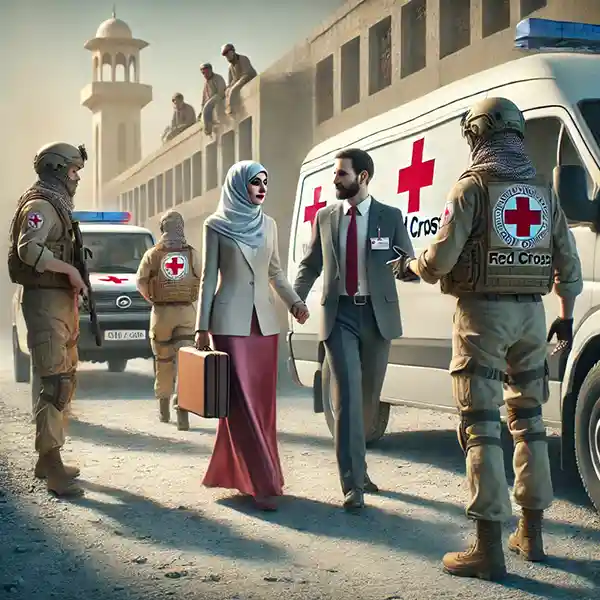
Image 2: A realistic depiction of Red Cross representatives facilitating the release of hostages in a neutral, professional setting. The scene includes a humanitarian backdrop with Red Cross symbols on vehicles and personnel uniforms. Hostages (men and women, looking relieved) are shown walking toward safety, accompanied by Red Cross officials.
Click Here to Read More under WGF What Is Series…
The Recent Ceasefire Between Israel and Hamas
The ongoing conflict between Israel and Hamas has been marked by violence, casualties, and humanitarian challenges. Recently, a ceasefire was brokered, bringing temporary relief to the region.
Key Highlights of the Ceasefire:
- Hostage Release:
- Hamas released three Israeli hostages to the Red Cross:
- Romi Gonen
- Emily Damari
- Doron Steinbrecher
- This marks the beginning of a process where Hamas is expected to release a total of 33 hostages over the next six weeks.
- Prisoner Exchange:
- In return, Israel has agreed to release 90 Palestinian prisoners, including both men and women.
- Humanitarian Aid:
- The ceasefire has allowed the entry of aid trucks into Gaza, addressing the urgent needs of its population.
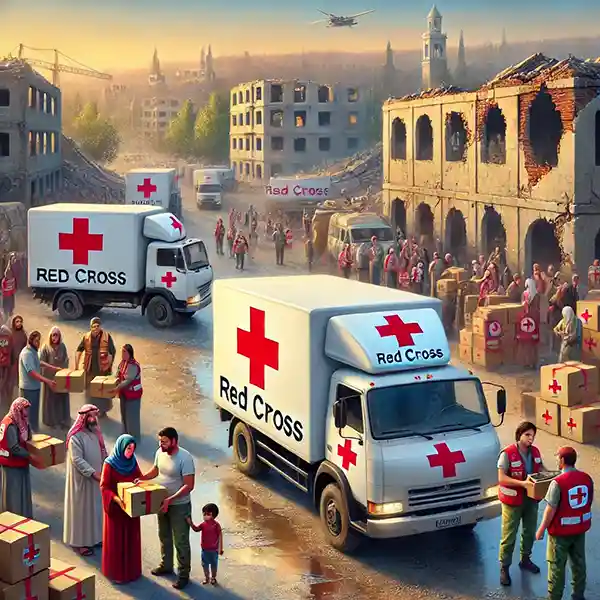
Image 3: A realistic depiction of humanitarian aid during a ceasefire in a war-torn region. The scene features Red Cross trucks delivering supplies such as food, water, and medical aid. Red Cross personnel in uniforms are seen unloading boxes with clear Red Cross symbols. Civilians, including families, are shown receiving aid with relief and gratitude.
Click Here to Read WGF Blogs from World Leaders…
Why Are Ceasefire Agreements Important?
- Humanitarian Relief:
- Ceasefires often provide the opportunity for humanitarian aid to reach affected populations.
- In this case, the delivery of aid to Gaza was a critical aspect of the agreement.
- Building Trust:
- The release of hostages and prisoner exchanges demonstrate goodwill, which can help build trust between conflicting parties.
- Paving the Way for Peace:
- Temporary halts in violence create opportunities for broader peace negotiations and long-term resolutions.
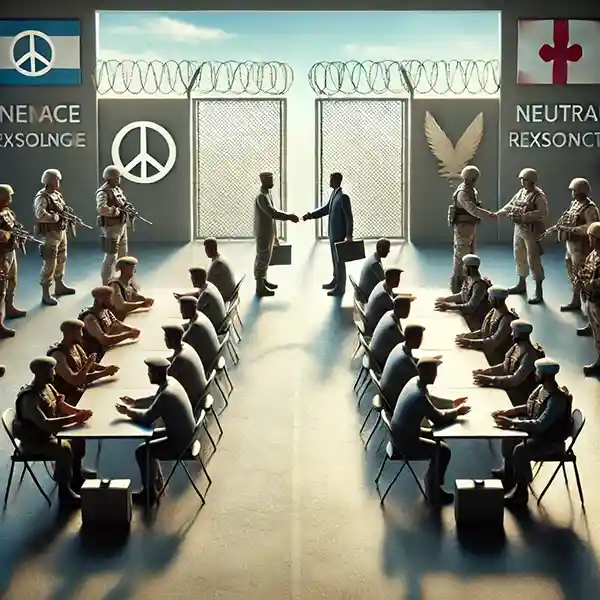
Image 4: A realistic depiction of a prisoner exchange process during a ceasefire. The scene includes two groups representing opposing sides, exchanging individuals in a neutral and secure setting. Mediators or neutral representatives oversee the process, ensuring fairness and calmness.
Click Here to Watch Keynote Speeches and Interviews of World Leaders at WGF YouTube…
The Role of the Red Cross in Hostage Situations
The International Committee of the Red Cross (ICRC) plays a crucial role in such scenarios. In this ceasefire:
- The Red Cross acted as a neutral intermediary to facilitate the safe release of hostages.
- Its humanitarian mission ensures the safety and dignity of individuals caught in conflict zones.
The Process of Prisoner Exchange in Conflict Zones
Prisoner exchanges are often sensitive and complex operations involving:
- Negotiation: Agreements are reached on the number and identity of prisoners to be exchanged.
- Coordination: Neutral parties like the Red Cross oversee the process to ensure fairness and safety.
- Execution: Hostages and prisoners are transferred simultaneously to prevent breaches of trust.
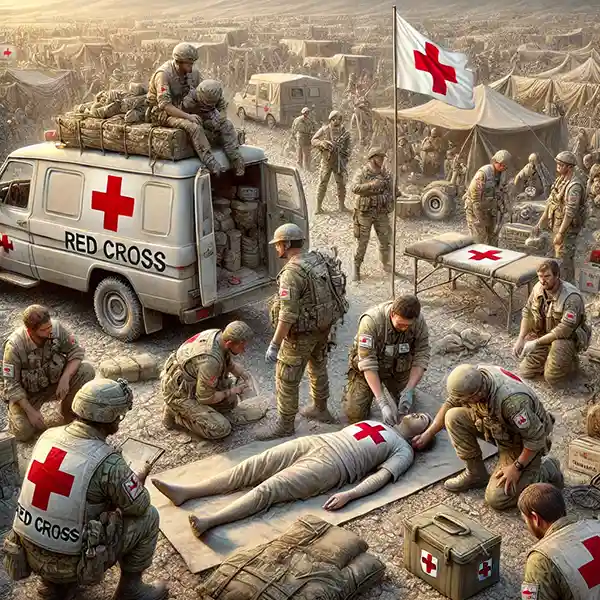
Image 5: A detailed and realistic depiction of the Red Cross in action. The scene shows Red Cross personnel providing medical assistance to injured civilians, distributing aid packages, and coordinating relief efforts.
Click Here to Watch WGF News on World Leaders at WGF TV…
Conclusion
The recent ceasefire between Israel and Hamas is a reminder of the delicate yet essential role of ceasefire agreements in mitigating conflict. By halting violence, facilitating humanitarian aid, and fostering negotiations, such agreements provide a glimpse of hope in otherwise dire circumstances. Understanding the mechanisms behind ceasefires and related processes helps us appreciate their significance in global peace efforts.
Follow World Growth Forums on the following for more updates…

